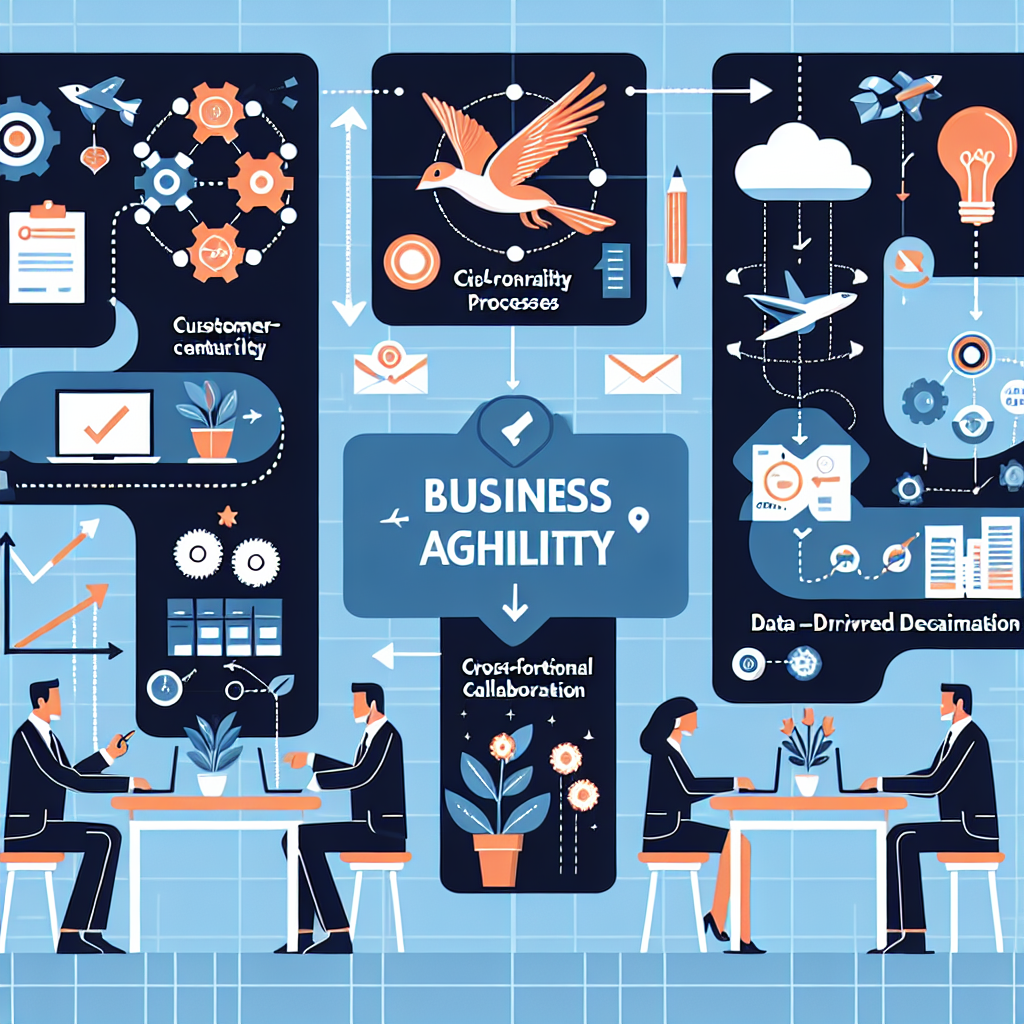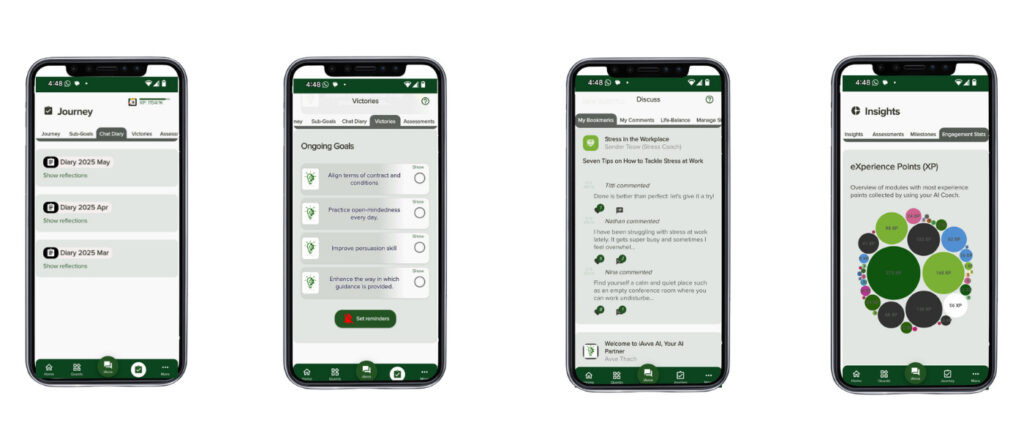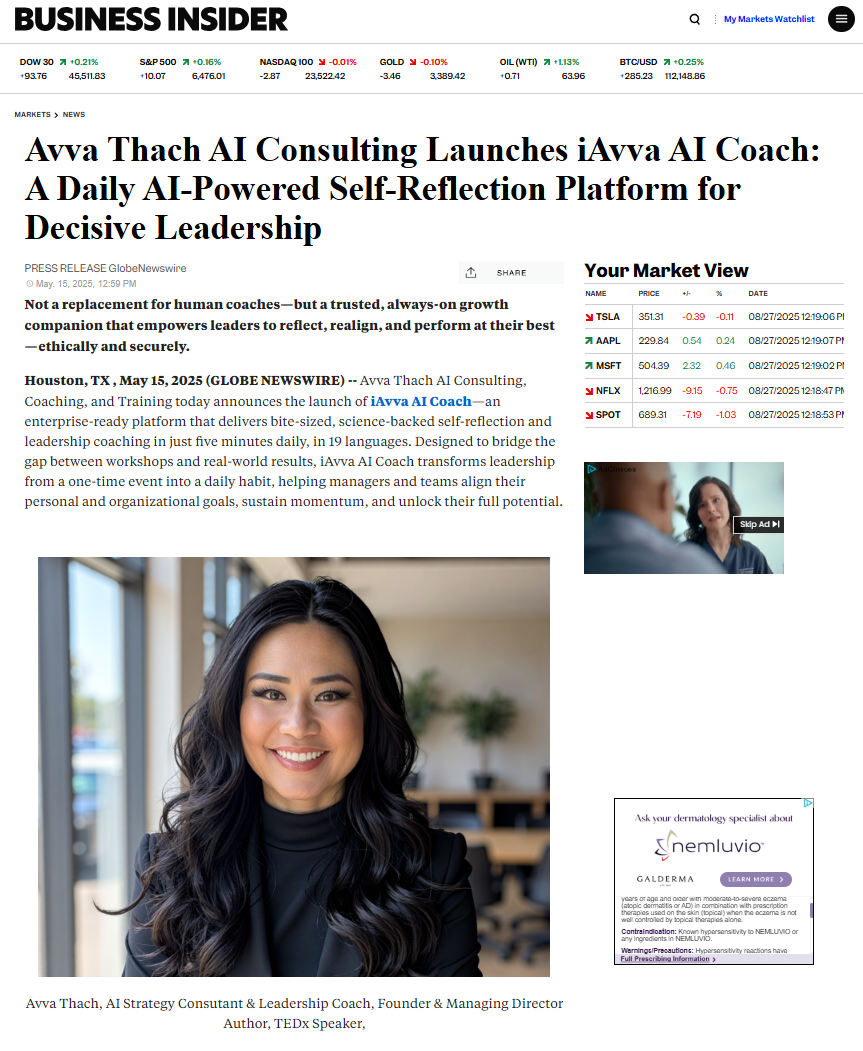Mastering Business Agility: A Guide to Thriving in Rapid Market Changes
Introduction
Welcome to the wild world of business agility, where the only constant is change! If you’ve ever felt like you’re trying to juggle flaming torches while riding a unicycle on a tightrope, then you know how crucial it is to master the art of agility in today’s fast-paced market. With rapid shifts in consumer preferences and technological advancements, organizations are finding that traditional business models just don’t cut it anymore.
In fact, a whopping 70% of organizations are either currently undergoing or planning to undergo an agile transformation. This isn’t just a trend; it’s a survival strategy. The ability to pivot quickly and adapt to new circumstances can mean the difference between thriving and merely surviving. Think of it as your business’s secret weapon against uncertainty.
But what does it really mean to embrace agile business practices? It’s about more than just slapping “agile” on your project management processes; it involves a fundamental shift in how your organization operates. From fostering an agile corporate culture that encourages innovation and resilience, to implementing frameworks that enhance your team’s flexibility in operations, mastering business agility is essential for any forward-thinking enterprise.
This guide will explore various aspects of business agility, diving deep into frameworks, practices, and leadership styles that can help your organization not just keep up with change but lead the charge. So buckle up as we embark on this journey toward becoming an agile powerhouse!

Understanding Business Agility
Welcome to the world of business agility, where adaptability is the name of the game! In a marketplace that changes faster than a cat meme goes viral, understanding business agility is crucial for survival and success.
So, what exactly is business agility? Simply put, it’s the ability of an organization to rapidly adapt and respond to market changes, customer demands, and emerging opportunities. Think of it as a gymnast performing on a balance beam one misstep can lead to disaster, but with agility, you can flip and twist your way to success!
- Definition of business agility: It encompasses the strategies, methodologies, and practices that enable organizations to respond swiftly and effectively in dynamic environments.
- Importance in today’s market landscape: With 93% of companies currently undergoing digital transformation (International Data Corporation), being agile isn’t just an option; it’s a necessity. Businesses that embrace agility are more likely to innovate and stay ahead of their competition.
- Key components of business agility:
- Organizational agility: The overall capacity of an organization to manage change effectively.
- Agile management: Techniques that promote flexibility in decision-making processes.
- Customer-centric approaches: Ensuring that customer feedback drives strategic decisions.
Key Takeaway: Embracing business agility leads to improved resilience, faster speed-to-market strategies, and enhanced innovation capabilities. Organizations must prioritize agility in their business models to thrive in today’s fast-paced environment.
The journey toward becoming an agile organization isn’t without its bumps. Common misconceptions include thinking that adopting agile practices means abandoning structure or that it’s only for tech companies. In reality, all businesses can apply agile principles from retail giants streamlining their supply chains to service providers enhancing customer experiences through iterative process improvements.
As we dive deeper into this guide on mastering business agility, keep in mind that it’s not just about surviving; it’s about thriving! Ready? Let’s flip the page and explore how you can implement a robust business agility framework!
The Business Agility Framework
The Business Agility Framework is like the Swiss Army knife of organizational adaptability. It equips businesses with the tools to pivot, adapt, and thrive in a landscape that’s as unpredictable as a cat on a hot tin roof. This framework is not just a set of guidelines; it’s a comprehensive approach designed to enhance business agility and ensure your organization can respond to rapid market changes with grace and speed.
Overview of the Framework
At its core, the Business Agility Framework is built around several key components that work in harmony:
- Vision Alignment: Ensuring that all team members understand and align with the company’s vision.
- Customer-Centricity: Prioritizing customer needs and feedback in every decision-making process.
- Iterative Processes: Emphasizing continuous improvement through iterative cycles, allowing for flexibility and adaptability.
- Cross-Functional Collaboration: Breaking down silos to enhance teamwork across different departments.
- Data-Driven Decisions: Utilizing real-time data to inform strategies and actions.
Elements of a Successful Framework
A successful Business Agility Framework incorporates several elements that are essential for fostering an agile corporate culture:
- Nimble Business Strategies: Crafting strategies that can be quickly adjusted based on market feedback.
- Agile Leadership: Leaders who inspire teams to embrace change and foster an environment of innovation.
- Dynamic Capabilities: Building capabilities that allow for rapid response to external pressures.
- Sustainable Practices: Ensuring that agility does not come at the cost of sustainability or ethical practices.
How to Implement the Framework in Your Organization
If you’re ready to embrace this framework, here’s how you can get started on your journey towards enhanced business agility:
- Create Awareness: Educate your team about the importance of business agility and how it impacts their roles.
- Select Agile Champions: Identify individuals within your organization who can lead by example and champion agile practices.
- Pilot Projects: Start with small-scale projects where agile methodologies can be tested before rolling them out company-wide.
- Evolve Continuously: Regularly assess your processes and be open to making changes based on what works best for your organization.
- Cultivate Feedback Loops: Establish mechanisms for gathering feedback from employees and customers alike this will fuel ongoing improvements!

Agile Business Practices for Organizational Success
In the fast-paced world of business, adopting agile business practices is no longer just a trendy buzzword it’s a necessity. As organizations strive for business agility, they must embrace strategies that foster adaptability and resilience. Here’s how you can implement agile practices to ensure your organization not only survives but thrives.
1. Adopting Agile Management Techniques
At the heart of an agile organization lies effective management. This means moving away from traditional hierarchies to a more fluid approach that encourages collaboration and rapid decision-making. Consider these techniques:
- Sprint Planning: Break projects into manageable sprints to allow teams to focus on delivering value quickly.
- Daily Stand-Ups: Foster communication and accountability by having teams meet briefly each day to discuss progress and obstacles.
- Retrospectives: After each sprint, hold a session to reflect on what went well and what could be improved, driving continuous improvement in processes.
2. Creating an Agile Organization Structure
Your organization’s structure can significantly impact its agility. A traditional top-down approach can stifle innovation and slow down response times. Instead, consider adopting:
- Cross-Functional Teams: Assemble diverse teams that bring together different skills and perspectives, enhancing problem-solving capabilities.
- Nimble Reporting Lines: Flatten hierarchies to speed up decision-making processes, allowing teams to respond more effectively to changes in the market.
- Empowered Teams: Give teams the autonomy to make decisions within their scope, fostering a sense of ownership and accountability.
3. Integrating Lean and Agile Principles into Operations
The integration of lean principles with agile methodologies creates a powerful synergy that drives efficiency and effectiveness. Here are some ways to blend these approaches:
- Value Stream Mapping: Identify waste in your processes and streamline operations for maximum efficiency.
- Just-In-Time Delivery: Implement strategies that deliver products or services precisely when needed, reducing inventory costs while enhancing responsiveness.
- Cultivating a Culture of Experimentation: Encourage teams to test new ideas without fear of failure this leads to innovation and keeps your organization ahead of the curve.
Key Takeaway: Embracing agile business practices isn’t just about methodology; it’s about fostering a culture where flexibility in business operations becomes second nature. The result? An organization that’s not only resilient but also poised for rapid growth!
Navigating Agile Transformation
Ah, the elusive agile transformation! It’s like trying to catch a greased pig at a county fair exciting but slippery. Fear not! With the right roadmap, you can successfully navigate this journey and enhance your business agility. Let’s break it down into digestible steps.
Steps to Initiate Agile Transformation in Your Business
- Assess Current State: Start by evaluating your existing processes and culture. Identify the gaps in your current operations that hinder agility.
- Define Clear Objectives: What do you want to achieve? Whether it’s faster time-to-market or improved customer satisfaction, having clear goals is essential.
- Engage Stakeholders: Involve everyone from leadership to front-line employees. Their buy-in is crucial for a smooth transition.
- Create a Pilot Program: Test the waters with a small team or project before rolling out changes across the organization.
Cultural Shifts Needed for Successful Transformation
A successful agile transformation is as much about culture as it is about processes. Here are some shifts you might need to embrace:
- Embrace Failure as Learning: Encourage teams to view failures as opportunities for growth rather than setbacks.
- Cultivate Cross-Functional Collaboration: Break down silos and promote teamwork across departments. Agility thrives in collaborative environments!
- Foster Transparency: Encourage open communication and visibility into processes and decision-making. This builds trust and enhances responsiveness.
Measuring the Success of Your Transformation Efforts
You can’t improve what you don’t measure! Here are some key performance indicators (KPIs) to track your progress in enhancing business agility:
- Cycle Time: Measure how long it takes for an idea to move from concept to delivery. Shorter cycles indicate better agility.
- Customer Satisfaction Scores: Use surveys or Net Promoter Scores (NPS) to gauge how well you’re meeting customer needs post-transformation.
- Employee Engagement Levels: Happy employees lead to happy customers! Monitor engagement through regular feedback and pulse surveys.
- Return on Investment (ROI): Assess whether your agile initiatives are yielding financial benefits compared to traditional methods.

Building Resilience and Flexibility in Business Processes
In the ever-evolving landscape of business, resilience is not just a buzzword it’s the lifeline that keeps organizations afloat during turbulent times. Think of it as the secret sauce in your recipe for business agility. Without it, even the most meticulously crafted plans can crumble like a house of cards in a gusty wind.
So, how do we cultivate this resilience while ensuring our operations remain flexible enough to pivot at a moment’s notice? Let’s dive into some strategies that can help you achieve just that!
The Role of Resilience in Business Agility
Resilience is akin to a rubber band; it stretches but doesn’t break. In the context of business agility, it enables organizations to withstand shocks be they market fluctuations, supply chain disruptions, or unexpected customer demands. Here’s why resilience matters:
- Adaptability: Resilient businesses can quickly adjust their strategies and operations based on real-time data.
- Risk Management: A resilient organization anticipates potential challenges and prepares contingency plans.
- Cultural Strength: Building resilience fosters a culture where teams feel empowered to innovate and take calculated risks without fear of failure.
Strategies for Enhancing Flexibility in Operations
If resilience is your foundation, flexibility is the architecture that allows you to expand and contract as needed. Here are some actionable strategies to enhance flexibility within your business processes:
- Implement Agile Methodologies: Adopt agile management techniques such as Scrum or Kanban to streamline workflows and improve responsiveness.
- Create Cross-Functional Teams: Encourage collaboration across departments to foster diverse perspectives and drive innovative solutions.
- Leverage Technology: Utilize digital transformation tools that provide real-time insights, enabling faster decision-making processes.
Did you know? Companies with high levels of organizational agility report up to a 30% increase in operational efficiency (Source: McKinsey & Company).
Continuous Improvement as a Core Principle of Agility
The journey towards becoming an agile organization is not a one-and-done affair; it’s more like an ongoing road trip where every pit stop offers an opportunity for improvement. Embrace the philosophy of continuous improvement by:
- A/B Testing: Experiment with different approaches and analyze outcomes to refine processes.
- User Feedback Loops: Implement systems for gathering customer feedback regularly this keeps your offerings aligned with market needs.
- KPI Monitoring: Regularly assess key performance indicators (KPIs) to identify areas needing adjustment or enhancement.
The essence of building resilience and flexibility in business processes lies in embracing change rather than fearing it. By fostering an agile corporate culture rooted in resilience, you’re not just preparing for change; you’re positioning your organization to thrive amidst it!
If you’re ready to transform your business into a model of adaptability and responsiveness, start by implementing these strategies today. Remember, agility isn’t just about speed; it’s about being smartly responsive!
The Role of Leadership in Fostering Agility
Leadership is like the captain of a ship navigating through turbulent waters without a steady hand on the wheel, you’re likely to end up in uncharted territory. In the realm of business agility, effective leadership is not just important; it’s essential.
The Importance of Agile Leadership Styles
Agile leadership styles are characterized by flexibility, collaboration, and an unwavering focus on outcomes. Leaders need to embody the principles of agile management to inspire their teams. This means:
- Encouraging experimentation: Allow team members to test new ideas without fear of failure.
- Being transparent: Share information openly to build trust and foster collaboration.
- Empowering teams: Delegate decision-making authority and encourage ownership.
Nurturing a Corporate Culture that Supports Agility and Innovation
A corporate culture that embraces agility is one where innovation can flourish. Leaders must cultivate an environment that promotes risk-taking and continuous learning. Here are some strategies to consider:
- Celebrate small wins: Recognizing incremental progress motivates teams and reinforces agile practices.
- Create safe spaces for feedback: Encourage open discussions where team members can voice their thoughts without judgment.
- Invest in training: Provide opportunities for professional development focused on agile methodologies.
Developing Cross-Functional Collaboration for Enhanced Agility
A key component of fostering business agility is promoting cross-functional collaboration. When different departments work together seamlessly, organizations can respond more swiftly to market changes. To enhance this collaboration, consider these tactics:
- Create cross-functional teams: Mix members from various departments to tackle projects collaboratively.
- Implement regular check-ins: Schedule frequent meetings for teams to align on goals and share progress.
- Encourage knowledge sharing: Foster an environment where team members can exchange insights and best practices across functions.

Takeaway: The role of leadership in fostering agility cannot be overstated. By adopting agile leadership styles, nurturing a supportive corporate culture, and promoting cross-functional collaboration, leaders can drive their organizations toward enhanced business adaptability and resilience.
Customer-Centric Approaches to Agility in Business Strategy
In the world of business agility, customer-centricity isn’t just a buzzword; it’s the lifeblood of agile practices. When businesses prioritize their customers, they unlock a treasure trove of insights that can fuel innovation and drive adaptability.
Imagine your business as a ship sailing through a stormy sea. Without understanding the currents (a.k.a. customer needs), you might end up lost at sea, while competitors who navigate these waters with precision sail ahead. Here’s how to ensure your business remains on course:
- Implement Customer Feedback Loops: Create mechanisms for gathering real-time feedback from customers. This could be through surveys, social media interactions, or user testing sessions. The key is to listen actively and iterate quickly based on what you hear.
- Utilize Data Analytics: Leverage analytics tools to gain insights into customer behavior and preferences. This data can guide your decision-making processes and help you tailor your offerings to meet evolving needs.
- Foster Cross-Functional Collaboration: Break down silos within your organization. Encourage teams from marketing, sales, product development, and customer service to collaborate closely. This holistic approach ensures that every department is aligned with customer needs.
- Create Agile Business Models: Develop flexible business models that can pivot in response to changing market demands or customer preferences. Think of it as building a bridge that can expand or contract based on traffic flow in this case, your customers’ needs.
- Embrace Continuous Improvement: Adopt a culture of continuous improvement where feedback is not only welcomed but acted upon swiftly. This iterative process allows businesses to remain relevant and responsive.
A great example of this approach in action is how companies like Amazon utilize customer data to refine their offerings continuously. By analyzing purchasing patterns and feedback, they manage to stay one step ahead of their competitors talk about agility!
Takeaway: Embracing customer-centric approaches not only enhances agility but also fosters loyalty and trust among your clientele, which is invaluable in today’s fast-paced market.
A Case Study: Successful Agile Implementation in Companies
<
- A real-world example of agile transformation success
- The impact on speed to market and decision-making processes
- Learnt lessons from the case study
>
>
The Future of Business Agility: Trends and Predictions
<
- Evolving trends shaping business agility
- Predicting future challenges and opportunities
- The role of technology in advancing business agility
>
>
Conclusion
<
- Synthesizing the importance of mastering business agility
- A call to action for organizations to embrace agility practices
>
>
“mainEntity”:[ {“@type”:”Question”,”name”:”What is business agility?”,”acceptedAnswer”:{“@type”:”Answer”,”text”:”Business agility is the ability of an organization to rapidly adapt and respond to market changes, customer demands, and emerging opportunities.”}}, {“@type”:”Question”,”name”:”Why is business agility important?”,”acceptedAnswer”:{“@type”:”Answer”,”text”:”Business agility is crucial as it enables organizations to innovate, stay ahead of competition, and respond swiftly to dynamic environments.”}}, {“@type”:”Question”,”name”:”What are the key components of a Business Agility Framework?”,”acceptedAnswer”:{“@type”:”Answer”,”text”:”The key components include vision alignment, customer-centricity, iterative processes, cross-functional collaboration, and data-driven decisions.”}}, {“@type”:”Question”,”name”:”How can organizations implement agile practices?”,”acceptedAnswer”:{“@type”:”Answer”,”text”:”Organizations can implement agile practices by adopting agile management techniques like sprint planning, creating cross-functional teams, and integrating lean principles into operations.”}} ] } ] }










Leave a Reply